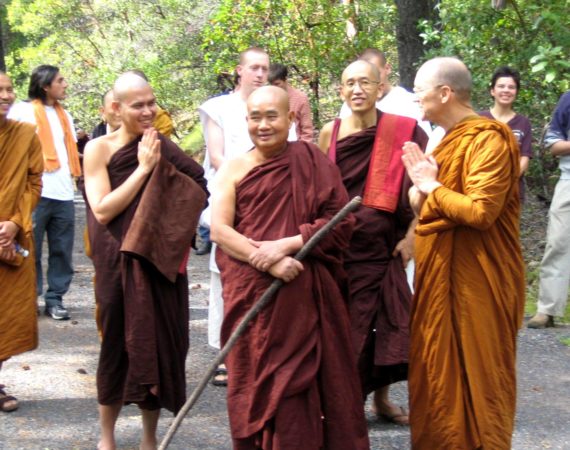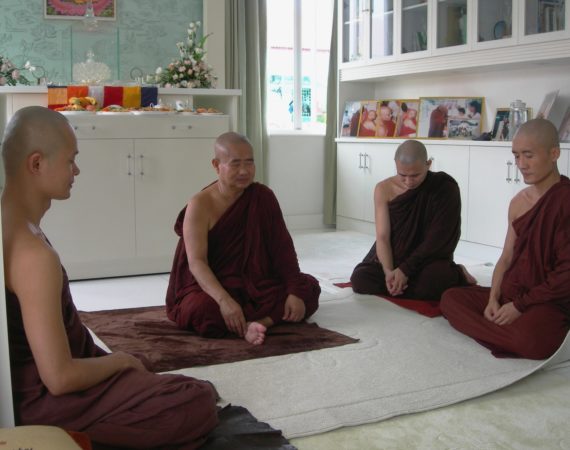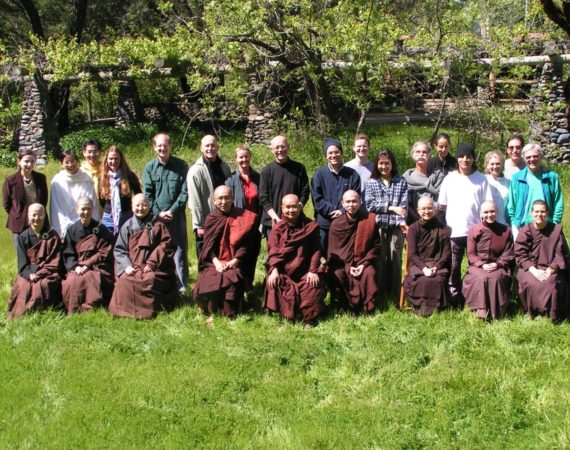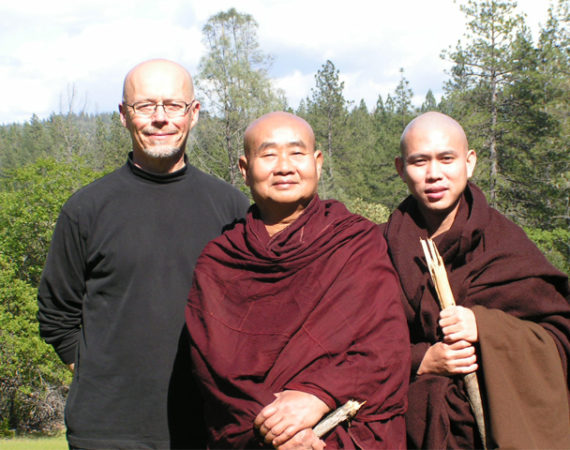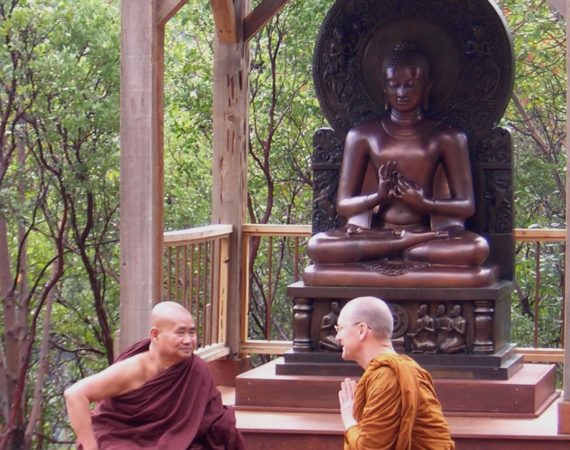Principle Teacher – Pa Auk Sayadaw

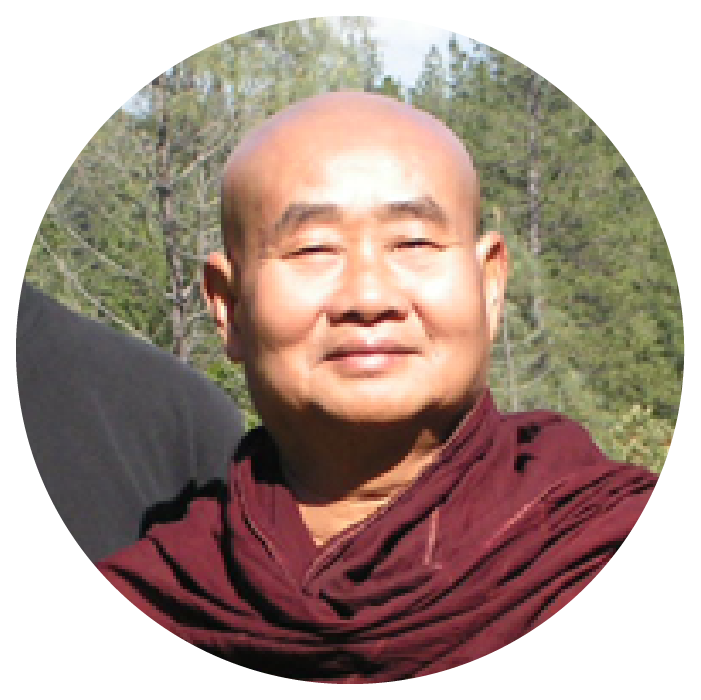
The Most Venerable Pa-Auk Tawya Sayadaw Bhaddanta Āciṇṇa
The Most Venerable Pa-Auk Tawya Sayadaw Bhaddanta Āciṇṇa, also commonly referred to as “Pa-Auk Sayadaw” (“the Sayadaw”), is the Abbot and principal teacher of Pa-Auk Tawya Forest Monastery, Mawlamyine, Mon State, Myanmar.“Sayadaw” is a Burmese honorific title meaning “respected teacher.”
The Sayadaw was born in 1934, in Leigh-Chaung Village, Hinthada Township, in the delta region about one hundred miles northwest of the capital, Yangon. In 1944, at age ten, he ordained as a novice monk (*samanera) at a monastery in his village. During the next decade, he pursued the life of a typical scholar-novice, studying the Pali Texts (including Vinaya, Suttas and Abhidhamma) under various teachers. He passed the three Pali language examinations while still a novice.
In 1954, at age twenty, the Sayadaw received the higher ordination as a bhikkhu. He continued his studies of the Pali Texts under the guidance of learned elder monks. In 1956 he passed the prestigious Dhammacariya examination and was conferred the title of “Dhamma Teacher”.
During the next eight years, the Sayadaw continued his investigation into the Dhamma, travelling throughout Myanmar to learn from various well-known teachers. In 1964, during his tenth “rains retreat” (vassa), he turned his attention to intensifying his meditation practice and began to practise “forest dwelling.” Although he continued with his studies of the Pali Texts, he now sought out and gained instruction from the revered meditation teachers of those times.
For the next sixteen years, he made forest dwelling his primary practice. He spent these years in the southern part of Myanmar, in Mon State: three years in Mudon Township (just south of Mawlamyine) and thirteen years in Ye Township (approximately one hundred miles down the coast). During this period, he lived a very simple life, devoting his time to meditation and studying of the Pali Texts.
In 1981 the Sayadaw received a message from the abbot of Pa-Auk Forest Monastery, the Venerable Aggapañña. The abbot was dying and asked the Venerable Acinna to look after his monastery. Five days later, the Venerable Aggapañña passed away. As the new abbot of the monastery, the Venerable Acinna became known as the “Pa-Auk TawyaSayadaw.” Although he oversaw the running of the monastery, the Sayadaw would spend most of his time in seclusion, meditating in a bamboo hut in the upper forested area, which covered a deserted range of hills running along the base of the TaungNyo Mountain Range. This area later came to be known as the Upper Monastery.
In 1997 the Sayadaw published his Magnum Opus, an enormous five-volume tome titled “The Practice that Leads to Nibbana”, explaining the entire course of teaching in details and supported by copious quotations from the Pali Texts.
Pa-Auk Sayadaw is held in high esteem by the international community of meditation practitioners for his role as an accomplished Dhamma and Meditation teacher. On January 4, 1999, in public recognition of the Sayadaw’s achievements, the government of Myanmar bestowed upon him the title Agga Maha Kammathanacariya, which means ‘Most Highly Respected Meditation Teacher’.
The Sayadaw speaks fluent English and has lectured and led retreats outside of Myanmar since 1997 such as the United States, United Kingdom, Germany, China, Taiwan, Japan, South Korea, Hong Kong, Sri Lanka, Malaysia, Singapore & Indonesia.
The Sayadaw’s teachings and Dhamma talks have been printed both in Myanmar and Englishwhich are highly regarded internationally. There are 42 books written in Myanmar, and 14 in English. Most of Sayadaw’s books have been translated into Korean, Indonesian, Thai, Vietnamese, and Chinese.
In brief, the system of meditation taught at Pa-Auk Forest Monastery is based on the instructions by The Buddha as found in the Pāli Canon (Tipiṭaka) and its commentaries. The system comprises the threefold training of strict observance of precepts (sīla), developing concentration (samādhi), as a basis for attaining wisdom (paññā). This is further subdivided into the seven stages of purification which provide a step-by-step formula for systematically purifying one’s body (physical actions), speech and mind of defilements in order to realize Nibbāna in this lifetime.
A brief biography of The Most Venerable Pa-Auk Tawya Sayadaw Bhaddanta Āciṇṇa
1934—The Venerable Pa Auk TawyaSayadaw was born on 24th June about 8.00 a.m on Sunday in Leigh-chaung Village, Hinthada township. He is the fourth son of U Phyu and Daw Saw Tin.
1944—On 2nd May, he was ordained as a novice under the preceptorship of Sa-linKyaung Venerable Sayadaw U Sona at Salin Monastery in Leigh-chaung Village.
From May 1950 to May 1952—He studied the Buddhist Scriptures (Pariyatti) in Ye-kyeeTaik–thitKyaung from Sayadaws: Venerable AshinMahinda, Venerable AshinPundavamsa and Venerable AshinPaññavanta. He passed the PathamaNge (Pali Primary) Examination in 1951 and the PathamaLatt (PaliIntermeditate) Examination in 1952.
1952—He studied Pali verse composition, rhetorical composition, higher Yamaka and Rupa-Siddhi for three months from Venerable SayadawAshinUttama of AungMingalaTheik-dhiKyaung in Kyi-myin–taing, Yangon.
1952—He moved to MasoyeinKyaung– taik in Mandalay in the month of Thadinkyut (around October). He then studied Patthana from Sayadaw U Suriya and U Sumana, the higher Yamaka from VinayaSayadaw and rhetorical composition from PaliSayadaw.
1953—He passed the PathamaKyi (Higher Pali) Examination.
1954—On 10th May he received his higher ordination in the Kanda Sima of Ye-kyeeTaik–thitKyaung, Hinthada Township under the preceptorship of the Most Venerable MavgalaSayadaw,AshinPanna, the sect president of Ye-kyee. The patron-donor then for the Venerable AshinAcinna was U San Chein, Daw Aye Tin and family of Hinthada Township.
1954—The Venerable AshinAcinna moved to Myin-wunKyaung – taik in Mandalay. He studied Bhedacinta, Atthasalini Commentary, SilakkhandhaVagga Commentary, Samanta-pasadika Commentary etc from various Sayadaws who are VenerablesPadamyaSayadaw U Ukkamsa from MyinWunTaikKyaung; AmarapuraSayadaw U Ukkamsa, Sayadaw U Ariya, Sayadaw U Kumara (now known as BamawSayadaw) and Sayadaw U Paññajota from PhayagyiKyaung-taik; Sayadaw U Suriya and Sayadaw U Puññananda from Taung-htee–linKyaung –taik.
1956—While staying in PhayagyiKyaung-taik in Ukkam, the Venerable AshinAcinna sat for an examination and passed with the title Sasanadhajasiripavara-dhammacariya.
1964—The Venerable AshinAcinna began to practice meditation in MahasiSasanaYeiktha Meditation Centre under the guidance of the Most Venerable MahasiSayadaw and Venerable Sayadaw U Pandita (now know as the Venerable ShweTaungGonSayadaw).
1964—The Venerable AshinAcinna began to practice forest dwelling during his 10thvassa. He also learnt meditation from: the Venerable Ka-thit–waingSayadaw for 10 days, the Venerable Than-lyinSayadaw who taught four elements meditation for 6½ months in 1966 and the Most Venerable Shwe-thein-daw TawyaSayadaw who taught mindfulness of breathing for 3½ months in 1967.
Since 1964—Practising forest dwelling, he stayed for: one Vassa in Taung-waing–gyiTawya near Nemindara Hill, Thathon; three Vassas in Citta-sukhaTawyaKyaung in Mudone Township; and 13 Vassas in Ah-sin TawyaKyaung, Ye Township. Now he has been staying in Pa Auk Tawya since 1981. While staying in those places, he studied the Buddhist Scriptures and practiced meditation as much as he can. Teaching meditation to local and foreign meditators as much as he can, he tries to promote and propagate Pariyatti (study), Patipatti (practice) and Pativedha (realization) of the Buddha’s teachings.
1966— He learnt meditation from the Venerable Than-lyinSayadaw who taught four elements meditation for 6½ months.
1967— He also learnt meditation from the Most Venerable Shwe-thein-daw TawyaSayadaw who taught mindfulness of breathing for 3½ months .
1996—The Most Venerable Pa Auk TawyaSayadaw received the title ‘MahaKammatthanacariya’ given by the government.
1999—The Most Venerable Pa Auk TawyaSayadaw received the title ‘AggaMahaKammatthanacariya’ given by the government.
Please follow his teachings in the format of e-book, audio, and video
